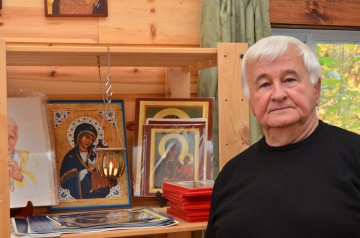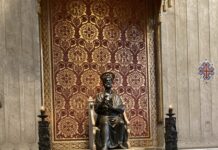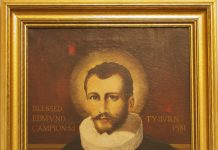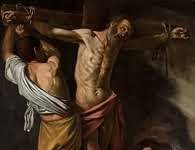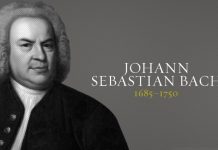Our December 2012 cover artist, Janusz Charczuk, is originally from Poland, where he graduated from the Technical University of Gdansk with a Master’s in Architecture. His studies encompassed the fine arts, including the principles of architectural forms, composition, freehand drawing, painting, sculpture, and the history of art. Janusz immigrated to Canada in 1985, where he worked as an architect, and began painting icons about fifteen years ago. His work, which is available for purchase, can be viewed at holyiconstudio.com.
What is this piece about?
This icon is called “The Holy Family” and shows the Holy Family of Nazareth. Mary and Joseph surround the young Christ Child in love. The Virgin holds the Child, and the Child playfully extends his hands to his mother. This icon shows us a meaningful picture of the tender and devoted relationship between Jesus, Mary, and Joseph, as well as their love and sacrifice for others. In this icon, the Christ Child is at the centre, with Mary and Joseph at his side. Jesus outstretches his arms to his mother with love and tenderness, and Joseph offers a guiding hand of fatherly support. “The Holy Family” icon is an example and reminder of the importance of family in both human and divine existence.
When did you start writing, or painting, icons?
I started about fifteen years ago—but the icons were always with me. I found a teacher; he is Armenian Christian, born in Iraq, where he attended art school. In the 1990s, he escaped with his family to Greece and found a job with a Greek iconographer, doing commissions, and learned the trade. From Greece he came to Canada, where he provides courses on iconography. I signed up and studied with him for two years. At a certain point, I decided it had been enough and I knew enough to go on my own.
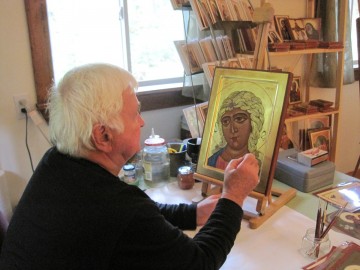
You mentioned the process of starting with a blank page.
Usually icons are on a piece of wood and consist of gold leaf, paint, and egg tempera. Egg tempera is a technique that is more than 1,000 years old. The first iconographers used this technique: preparing the wood board, then applying gesso, then applying gold leaf. What you see here is not paint or a substitute: it is 23-carat gold.
How do you apply gold leaf?
There is a special technique. There is oil gilding or water gilding. I do oil gilding, which is done after the gesso is prepared. I know where the gold leaf will be, and apply a special surface to which the gold leaf will stick. Then I apply paint. In general painting—oil painting, acrylic, watercolour—the artist goes from light to dark. In iconography it is the reverse. I start with the darkest and build layers of paint to the lightest colour.
Why is the technique called “egg” tempera?
Egg yolk works in this technique as a hardening agent. I take an egg and separate the yolk, which is covered in a thin membrane. I grab the membrane and poke, and the yellow yolk comes out. I mix this with water and a little bit of vinegar, mix the paint with the egg yolk, and start applying it using small strokes. It is not wide-stroke painting. The brushes are calligraphy brushes, very thin and long.
![]()
What does it mean to “write” an icon?
The process of painting an icon is also called “writing” an icon. Both terms are correct, but by saying that icons are written it is easier to understand that they are meant to be read.
How long does it take to complete an icon?
It takes time. Icons originated in monasteries, where each step was specialized. One man would prepare the board. One man would make gesso, which is marble dust and rabbit skin glue. It is the consistency of sour cream and is applied with a spatula or brush on the board in about sixteen layers. Then the gesso is sanded. When it is done, it is almost as smooth as glass. Then the drawing is applied.
Do you sketch the drawing on the wood?
Usually iconographers copy old icons and then transfer the patterns to new boards. When the drawing is done, I scratch an outline of the image on the board with a very thin needle. I apply dark colour to the line, to see it, and then apply the gold leaf. Then I start painting, from dark to light. I begin with the clothes and then move to the faces. The last step is to put names on the icons.
Are icons always copied?
Some iconographers copy icons—to which some say that it is not “creative” work. I agree, we are copying; but every hand is different. Every eye is different. It is so much my work in this icon. This icon is mine. The icon consists of my DNA. There is a firm belief among orthodox iconographers that the artist should not significantly change icons. I think this is right. Icons survived for so many centuries unchanged precisely because of this strict law. But I also think there is nothing wrong with applying the old rules of Byzantine iconography to creating new icons; sometimes I use my imagination to design my own icons.
Would you show me some of your original icons?
This icon is the only one in the world. I call this “Virgin Mary of Kashubia.” More than 150 years ago, Poles from the Kashubia region immigrated to Canada. They settled in Barry’s Bay and Combermere, by Our Lady Seat of Wisdom Academy. At first, life was very harsh. But they were very religious and prayed every day. The first thing they did was put crosses on the crossroads. They were honest, hardworking people. Seeing the region gave me the idea to design the Virgin Mary of Kashubia.
![]()
The flower pattern is an embroidery pattern from hundreds of years ago in Poland. There are three distinct blues. There is a dark blue; this symbolizes the sea. The lighter blue symbolizes Kashubian lakes. The light blue symbolizes the Kashubian sky. This region in Canada is similar to the region in Poland: it consists of lakes, streams, hills, and forests. The icon is done with the traditional technique, but the subject is different. I don’t think there is anything wrong with making icons to saints or martyrs; I don’t think we should only paint St. George as a martyr. We have new saints and martyrs.
![]()
I designed this icon as well; I call it “Virgin Mary of Gdansk.” Gdansk is the city in Poland where I came from. In her halo, the Virgin has amber from the Baltic Sea. The Gdansk region is famous for amber. Because this is a harbour, Jesus is wearing a sailor’s uniform. This is unique; I have never seen Jesus wearing a sailor’s uniform in any icon. Instead of holding the Bible, he holds a ship.
![]()
It is unique. At the same time, it is done according to the rules that govern Byzantine iconography.
How long does it normally take to finish one icon?
It depends on the size and complexity. For example, when I started the “Virgin Mary of Gdansk,” it took me about four or five months to complete a sketch. Then I started painting. The final product was complete after a year, for this icon. When you copy an image, it takes about three or four months. It is a lengthy process.
You mentioned that the process is a prayer, a spiritual journey. I can see this in your original icons, because they contain so much of your background, but how is the spiritual journey expressed even in the copies?
I think that every person has his or her own journey into iconography. I was blessed to find icons. I always enjoyed looking at them, but I had to learn the technique. It was not easy. The person who is thinking of doing icons should be ready spiritually to accept the rules and the hard work. My icons are not signed, like regular art. Generally, icons should not be signed. When you see the old icons, the pieces are anonymous because there is a common belief that the real author of the icon is the Holy Spirit, that the Holy Spirit is just borrowing my hand to do the work.
![]()
Would you explain this icon?
This is called “Virgin Mary of Smolensk.” This icon has existed for 1,000 years. It was brought from Byzantium to Russia and was a wedding gift to a Byzantine princess who married a Russian prince. This icon is in Smolensk, a city in Russia; terrible things happened in this region, and she [the Virgin Mary of Smolensk] saw all of it. Then, on 10 April 2010, a plane with the Polish president and dignitaries on board crashed in Smolensk. My friend was on this plane. Having this in mind, I decided to make a new icon of the Virgin Mary of Smolensk. There were 96 people killed, so I put 96 crosses on the border. The checked square is the emblem of the airline, and the birds are each the Polish eagle.
When someone is “reading” an icon, how would they see the story behind it if the artist were not present to explain it?
First of all, icons are not intended as decoration. They are beautiful. They calm you down. They do not make you angry, or excited, or nervous. They just calm you down. The main purpose, I think, is to initiate prayer and contemplation. You don’t have to say anything, just look and contemplate in silence. It is a speaking silence; the silence speaks itself. Also, the icons watch you—their eyes follow you, as if they are looking at your soul.
![]()
This icon is different.
Yes. Some icons show the Virgin Mary playing with the Child, and the Child is touching her face. The image is not as serious; it is playful.
What was the first icon?
The first type of icon is “not made by human hands.” The story is that while Jesus was alive and preaching and doing miracles, there was a small city called Edessa. Its king, Abgar, was sick with leprosy. He had heard of the miracles of Jesus, and sent his servant to see if Jesus could help him. The servant went. Jesus said he could not go, but he put a cloth to his face, and the image of his face was imprinted on it. He told the servant to go to the king and show him the cloth. The servant did, and Abgar was cured. After that, Abgar ordered that the whole kingdom become Christian.
![]()
What other types of icons are there?
There are the saints, the angels—the most important is St. Michael the Archangel. There is a beautiful sculpture of St. Michael in St. Michael’s Hospital that I used as inspiration for a new icon of St. Michael—”The Urban Angel.” His Eminence Thomas Cardinal Collins accepted this icon as a gift to commemorate his elevation to the College of Cardinals in Rome on 18 February 2012, by Pope Benedict XVI. Here, St. Michael is an “urban” angel. There is a story about the statue. In the 1850s there was an epidemic, and the Health Department of Toronto asked the Sisters of St. Joseph to organize a new hospital. They organized a new hospital on Bond Street, which today is St. Michael’s Hospital. In the beginning there was about 23 beds. The sisters were poor; they were buying old beds and linens in second-hand stores. One time they went to the store and saw a statue, dirty and covered in dust, but they recognized that it was St. Michael. They bought it and brought it to the new hospital, where they cleaned it—and a beautiful white marble statue appeared. From then on the statue was in the entrance to the hospital. Ten years ago or so they built a new wing and moved the statue there. During the move, they saw chiselled on the back, “Pietrasanta,” where the marble for Michelangelo’s Pieta was taken. Nobody knows how the statue came to Canada.
![]()
What do you do with your pieces? Are they ever shown? Are they for sale?
They are shown from time to time in different exhibitions (for example, the Madawaska Valley Studio Tour). They are also for sale. I have donated a few to different churches and organizations.
